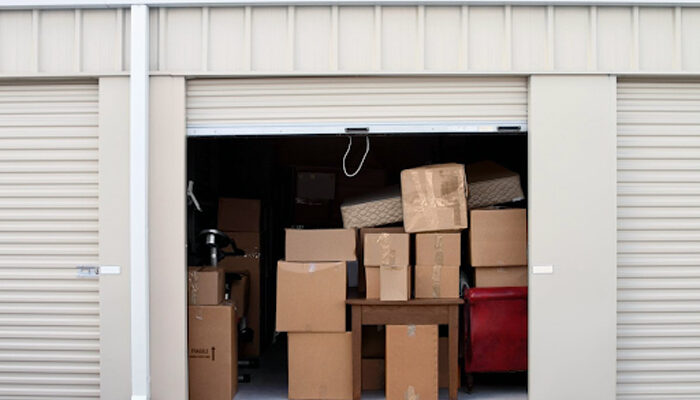
The average 10×10 storage unit costs about $98/month.
It’s one thing if you’re using self-storage to temporarily house big-ticket items during a move. $300 to keep your favorite china cabinet and sectional in good condition is no big deal.
But that $98 adds up to $1,176 a year.
And if you rent a larger unit, temperature-controlled, on the ground floor, or in high-demand, your fees may exceed your annual car payments.
It doesn’t have to.
Don’t force yourself to choose between those family heirlooms and keeping food on the table. Use these seven self-storage tips that’ll help you save money instead!
1. Only Store What’s Worth Keeping
Before you mindlessly start packing those moving boxes to load into your new storage unit, ask yourself:
Will I need this next week? Next month? Next year?
If it’s only collecting dust — like that VCR from the 90s — or won’t match the decor in your new crash pad, consider donating it to Goodwill or selling it on LetGo.
Remember, every square foot in your storage unit will cost you. And by scaling down from a 10×15 unit to a 10×10, you can save about $30/month or $360/year.
Here are the things worth putting into storage:
- Baby supplies (especially if another baby is on the horizon)
- Antiques or vintages items that’ll only increase in value
- Collectibles, memorabilia, family heirlooms
- Seasonal decor or holiday displays
If this storage unit is more of a long-term solution, hold off on storing electronics or furniture items that may become outdated within a year or two.
2. Preserve Space With Strategic Packing
Packing a storage unit is like a game of Tetris.
In other words, to get the most bang for your buck on a 10×10 unit, you want to make good use of every square inch you have — both vertical and horizontal!
Luckily, this puzzle is much easier to solve.
Start by saving space during the packing process. Stuff small items into drawers, use vacuum-sealed bags to compress bulky bedding, and fill your boxes to the brim.
Next comes the puzzle itself.
Disassemble big furniture and lean it against the walls. Stack boxes as high as safely possible, and start filling the back of the unit before working your way forward.
And don’t forget:
Leave the items you’re planning to recover first toward the front of the unit. That way, you don’t have to climb over boxes or rearrange the unit every few months!
3. Choose a Nearby Storage Facility
Renting a moving truck is one of the most surprisingly over-priced expenses that come with a big move.
There’s the daily flat fee (usually about $20/day).
But you’re also on the hook for every mile you put on the odometer. And at $0.40-$0.99/mile, every detour you make will only add to your truck rental bill.
That self-storage facility 30 miles away might come at a $20/month discount. Yet, if it costs you an extra $60 to drive there and back, those savings all but disappear.
Stick to local storage facilities within a few miles of your current home.
4. Don’t Forget About the Freebies
Self-storage is in no way cheap. However, many facilities come with unique bonuses and freebies to entice more folks like you to rent units long-term.
If you want to save money, don’t let them go to waste!
Give a little more thought to facilities that offer things like:
- A free month (or even your first month for $1)
- Free or discounted moving truck rentals (some facilities have their own!)
- A free lock on your unit
- Discounted upgrades (like temperature-controlled or ground floor)
But even more importantly: Read the fine print.
For example, if you need short-term storage and the first month is free, you might think that’s a “steal.” Yet, the owner might require you to sign a 13-month contract.
If it sounds too good to be true, it probably is!
5. Skip Self-Storage Altogether
Why spend $100/month on a storage unit when you can possibly store your items for free — or at least at a steep discount?
Someone in your contact list has open space in their garage, shed, or basement.
So … ask!
Find out if one of your buddies (or even your parents) can lend you some square footage as you finish getting settled in or complete a few renovations.
And don’t forget to offer them a crisp $20 or $50 for their kindness.
6. Only Pay for What You Need
Many people are firm believers in the “you never know” mindset.
After all, it’s better to have a few extra square feet, a heating feature, and a long-term storage space “just in case,” right?
Not exactly!
Every add-on and perk is an extra $15-$50/month in out-of-pocket moving expenses.
Before you sign the contract upgrading your unit, ask yourself whether you really need it or if it’s merely a convenience feature.
An extra $10/month for a ground unit on a three-month rental isn’t a big deal.
But if you’re only using your unit to store seasonal decor for several years, that $10 can become thousands.
7. Shop Around at Local Facilities
Unfortunately, $100/month in rental fees can go much further at one self-storage facility than another.
So don’t settle for the first unit you can find!
Do your research.
Find out if there are price differences at certain times of the year, between local and chain facilities, and in the city vs. in the suburbs.
Why spend an extra $20/month on a tiny self-storage unit when you can get a free truck rental or a temperature-controlled unit at another location?
Conclusion
You can easily save at least $98/month by skipping out on the storage unit altogether.
But why stop there?
Here are a few other “moving hacks” to keep even more cash in your wallet:
- Borrow a friend’s pick-up truck to transport the smaller items
- Visit your local grocery store and ask if they have any spare egg boxes
- Move during the middle of the month (or in the off-season)
- Organize a group of friends to help out rather than hiring a moving crew
Even if you’re moving across town, the average “local” move will cost you around $1,250. Skip on the luxuries (like wardrobe boxes) and put in some elbow grease.
[Author Bio:]
Adam Marshall is a freelance writer specializing in all things apartment organization, real estate, and college advice. He currently works with Quarry Trail to help them with their online marketing.

Leave a Reply